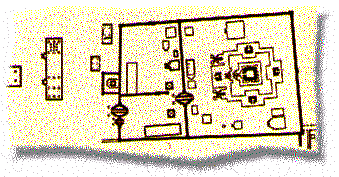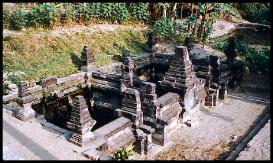

It is the greatest
religious complex of east Java . This unit is particularly interesting because
it remains the only still visible example of a type of very widespread sanctuary
at the time of Mojopahit and which will be reflected until Bali. It is located
at 10 km in the north of Blitar on the slopes of the Kelud mount. Its construction
started about 1330 and was spread out over 50 years. But the oldest inscription
which is engraved on a stone in the south of the principal monument indicates
1197, and most recent indicate 1454.
 The whole of the structures are distributed
on three terraces which rise in steps from the entry to the bottom of the enclosure.
These three zones were closed and formed enclosures which one crossed by large
doors of the type of those that one can see in Trowulan, and which will be take
up again in the balinese temples . The terraces are composed primarily of temples
and platforms of dances.
The whole of the structures are distributed
on three terraces which rise in steps from the entry to the bottom of the enclosure.
These three zones were closed and formed enclosures which one crossed by large
doors of the type of those that one can see in Trowulan, and which will be take
up again in the balinese temples . The terraces are composed primarily of temples
and platforms of dances.
Several structures are surrounded
by broad carved stringcourses. Many palaces and other buildings are represented
there. It is noted that these constructions often comprise roofs out of wooden
and on several levels superimposed such as one sees them in Bali today still.
These timber constructions were most numerous by far at that time; they have
of course, and unfortunately, all disappeared.
Starting from the entrance
, one will stop especially in front of the large carved platform opposite the
entrance, the "dated temple", the temple with the snakes, and finally in front
of the principal temple. At the outside of the enclosure one can see two baths
. The principal terrace at summer built in 1347.
The carved terrace:
The three large terraces consist of a brick solid mass covered with a stone
plating. The reliefs of the lower level represent episodes of Ramayana.
Another decoration,
moralist, try to show the good way by comparing the life of two characters,
a very thin vegetarian named Gagang Aking and the large Bubukshah which eats
meat.
The dated temple:
The date 1369 is engraved on the lintel of the door western side. In the cella
is a statue of Ganesha . Representations of the "sun of Mojopahit" are engraved
on the sides of the capital of this temple.
The temple with the snakes: On this well preserved temple are carved in rounds bumps enormous snakes, guards of the treasures locked up inside, carried by priests.
All the top of
the monument built out of wood as of the balinese merus disappeared.
The principal
temple: This temple which was collapsed was re-installed in two structures posed
one beside the other, and correspondent with three terraces of the monument
of origin. One sees there stringcourses of sculptures of the wayang type
drawn from Ramayana on the first terrace and Krishnayana
over the second.
The brought back structure of the principal temple: One will notice the many representations of animals.

Baths: These baths
which carry engraved in decoration the date of 1415 are still used today.
They are illustrated
with animals drawn from the stories of Tantri.
![]()